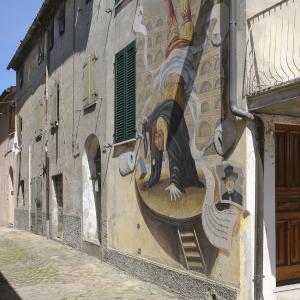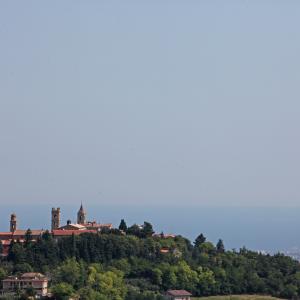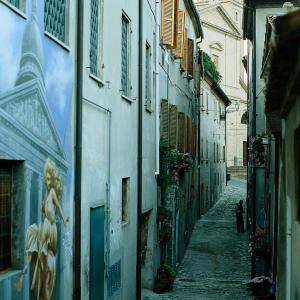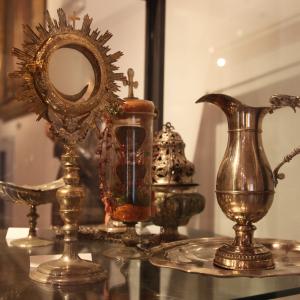13 things not to miss in Saludecio
Elegant, an austere outline with 19th-century echoes, Saludecio offers much. Surrounded by a gentle, elongated landscape, the centre alternates refined palaces and important sacred buildings with the simpler village houses. Recognisable by its three bell towers, Saludecio is also the town of murals.
Marina Gate 14th century
A fine tower structure with lancet archway; this is the entrance to the village and leads to the main square.
Belvedere
This is a panoramic balcony overlooking the sea and encompasses the Monument to the Fallen (1928), the fountain and the square dedicated to Santiago de Compostela. Viale dei Tigli begins here and leads to the Italian Garden and Rimembranze Park in Porta Montanara.
Piazza Santo Amato Ronconi
With a regular layout, the square dates from the period of Sigismondo Pandolfo Malatesta; it is the heart of the town and is overlooked by the parish church and the town hall.
Town Hall Houses several cultural institutes such as the Theatre, theLibrary and the Permanent Exhibition of Giuseppe Garibaldi memorabilia, soon to be the Risorgimento Museum. It was built on the remains of the ancient Malatesta fortress of which traces of the walls are still visible.
Parish church of San Biagio (1930) Sanctuary of the Santo Amato 18th century
The imposing structure with a centralized layout, in perfect neo-classical style, stands on the site of anancient mediaeval church within the walls. Given its size, the wealthof pieces it contains and the presence of the mortal remains ofBlessed Ronconi it is considered the cathedral of the Conca valley.
Saludecio and Santo Amato Museum
Communicating with the church, this is a treasure chest of furniture, vestments, church furnishings, devotional items and ex voto linked to the cult of the Blessed Amato, as well as great works of art like the Beheading of John the Baptist by Claudio Ridolfi known as “Il Veronese” 1605, The Procession of the Holy Sacrament by Guido Cagnacci 1628 and St. Sixtus Pope 1628 in the church.
Municipal Tower 14th century
A mediaeval tower that characterizes the town’s skyline.
Monastery of the Hieronymites 17th century
Part of the church building, it has a fine classical portal and is an important complex in the upper part of the town.
Montanara Gate 14th century
Opposite Marina Gate, this is also fortified but less imposing. It faces towards the Apennines to control the Montefeltro.
Murals
A multicoloured and unusual open-air museum winds its way through the narrow streets and squares of the old town of Saludecio revealing 19th-century inventions: each summer murals are painted during the 800 Festival on the walls of the houses of the village (about 50 pieces) by the artists of the “Genius Loci - Ar.Per.C.” (Artistic and Environmental Cultural Association of Castellabate-Salerno). Thanks to these precious characteristics, Saludecio is now one of the main towns in AssIPaD (Italian Association of PaintedVillages) and Res Tipica.
“N. Copernico” Astronomic Observatory
In the countryside of Santa Maria del Monte, two telescopes search the skies; one is dedicated to scientific research, whilst the other is open to the public.
Meleto Castle
A fascinating fortification in the village of the same name just a few kilometres from the centre. It is surrounded by stretches of old walls, with a large internal courtyard. It is like a balcony overlooking the Adriatic, situated in a panoramic position in the valleys of the Tavollo and Foglia rivers.
Cerreto Castle
An outlying village in the Ventena valley that has an intimate beauty. Surrounded by greenery, it retains traces of the mediaeval fortified structure with the village dominated by the municipal tower that has become the church bell tower. Ancestral Carnival rites have been recovered here, animated by the strange stories of its inhabitants and archaic masks such as the ivy-man, theold woman, the counts and the clown and the straw cone, which isset alight in a climate of general hilarity.
Taken from Malatesta [&] Montefeltro: a journey through the hills of Rimini.



